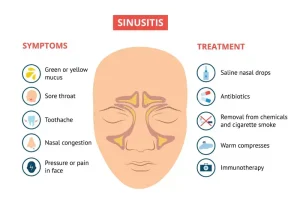Overview
How Acute Sinusitis is Diagnosed
A healthcare provider may use several methods to diagnose acute sinusitis and rule out other conditions:
1. Physical Examination
-
The provider checks for tenderness in the nose, cheeks, and forehead
-
May look inside the nose to examine swelling or discharge
2. Nasal Endoscopy
-
A thin, flexible tube with a light (endoscope) is inserted into the nose
-
Allows the provider to see inside the nasal passages and sinuses
3. Imaging Studies
-
CT scans can provide detailed images of the sinuses and nasal area
-
Usually not needed for simple acute sinusitis but useful to rule out other causes
4. Nasal and Sinus Samples
-
Lab tests are rarely needed for typical sinusitis
-
Samples may be taken if symptoms persist, worsen, or don’t respond to treatment
Treatment Options for Acute Sinusitis
Most acute sinusitis cases improve on their own. Self-care and symptom management are often sufficient.
Self-Care & Symptom Relief
-
Saline nasal sprays: Rinse the nasal passages multiple times a day
-
Nasal corticosteroids: Reduce inflammation (e.g., fluticasone, budesonide, mometasone, beclomethasone)
-
Decongestants: Tablets, liquids, or sprays; use nasal sprays for a short period to avoid rebound congestion
-
Allergy medicines: Helpful if sinusitis is triggered by allergies
-
Pain relievers: Acetaminophen, ibuprofen, or aspirin (avoid aspirin in children and teenagers with flu-like symptoms due to Reye’s syndrome risk)
Antibiotics
-
Not effective for viral infections, which are the most common cause
-
May be prescribed for severe, worsening, or long-lasting bacterial sinus infections
-
Always complete the full course of antibiotics
Immunotherapy
-
Allergy shots (immunotherapy) can help if allergies contribute to sinusitis
When to See a Doctor
Seek medical attention if you experience:
-
Severe or worsening symptoms
-
Symptoms lasting more than 10 days
-
High fever, swelling around the eyes, or severe headache
Advertisement

